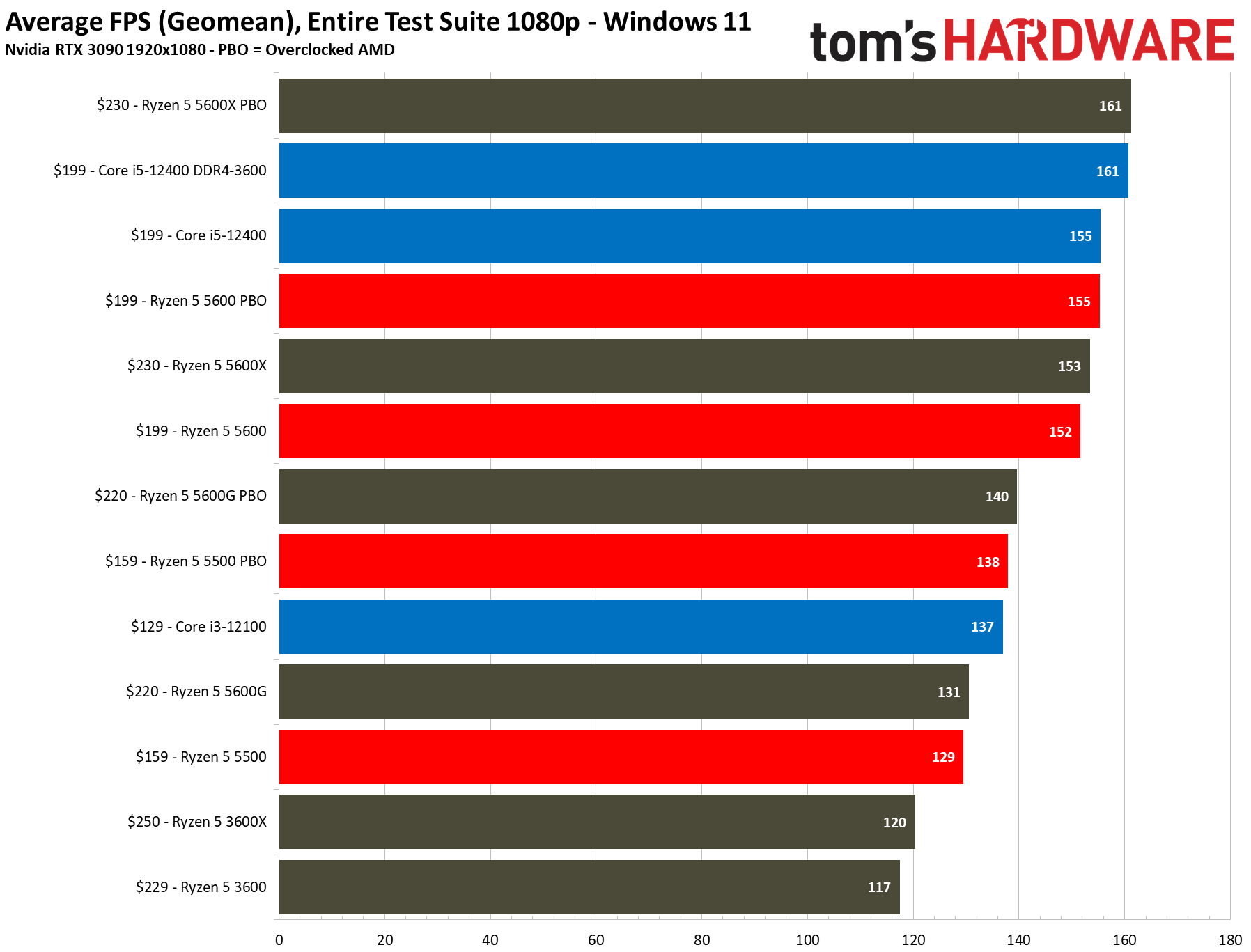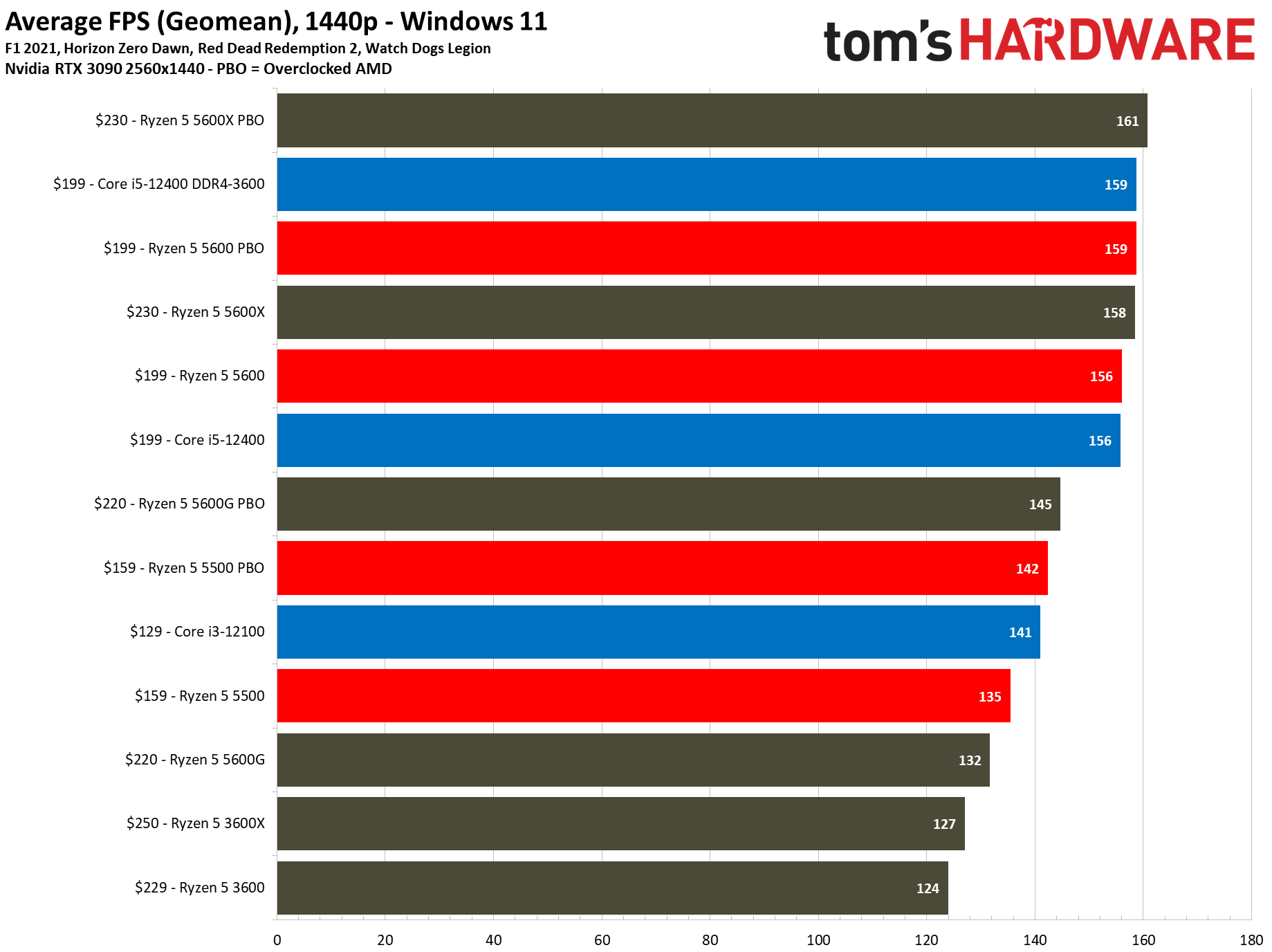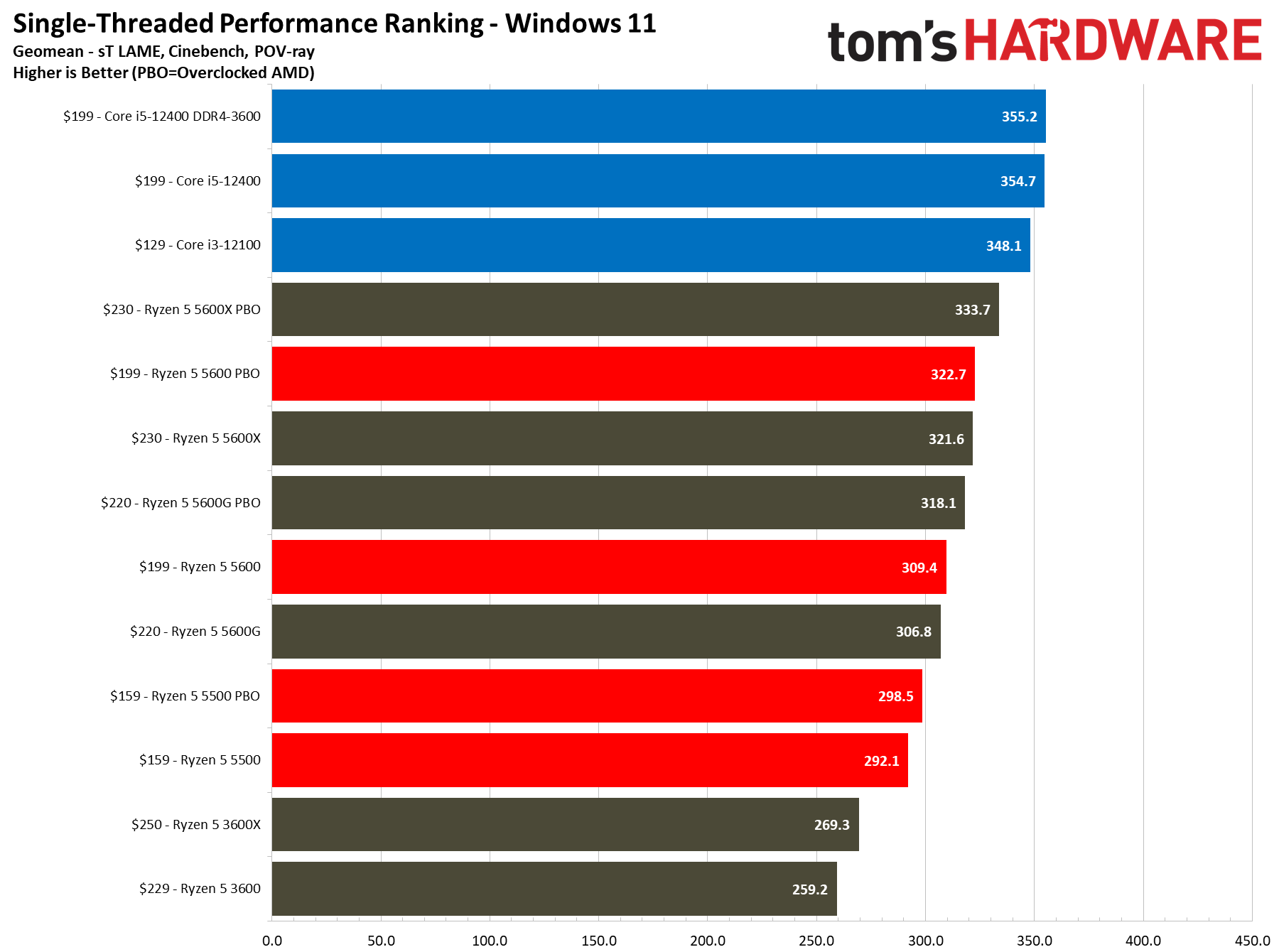Why you can trust Tom's Hardware
The arrival of AMD's Ryzen 5000 found the company with a clear performance lead over rival Intel chips, so the company prioritized high-priced high-margin chips and largely abandoned the budget market. The arrival of Alder Lake has changed the paradigm entirely, spurring AMD to finally bring Zen 3 to the budget arena.
AMD's non-X $199 Ryzen 5 5600 and $159 Ryzen 5 5500 lower the bar for entry to the Zen 3 architecture and provide access to the lowest-priced AM4 motherboards via retroactive support on older boards, but these chips don't retake the overall performance lead in their price brackets. Instead, they slot in as a solid upgrade for existing AMD system owners or as a value alternative to Intel's Alder Lake for new system builds.
Below, we have the geometric mean of our gaming test suite at 1080p and 1440p and a cumulative measure of performance in single- and multi-threaded applications. We conducted our gaming tests with an RTX 3090, so performance deltas will shrink with lesser cards and higher resolution and fidelity settings.




At stock settings, the Core i5-12400 is 2% faster than the Ryzen 5 5600 in our cumulative measurement of 1080p gaming performance and 3.9% faster after overclocking. In our multi-threaded application benchmarks, the Core i5-12400 is 2.8% faster than the Ryzen 5 5600 at stock settings and 5.5% faster after tuning. It's also 15.6% faster in single-threaded applications.
Both chips retail for around $199, leaving the Ryzen 5 5600 in a tricky position. If pricing stays in line with the MSRP, the 5600's primary advantage will be its access to cheaper motherboards that lower the total platform cost. However, the AM4 platform is long in the tooth, and you'll sacrifice the PCIe 4.0 interface if you go with older boards.
Additionally, while the 5600 lacks integrated graphics, the 12400 has the built-in UHD graphics 770 engine to provide at least a basic display out. You could also go with the graphics-less 12400F for ~$175, which helps reduce the impact of the extra costs associated with motherboards for Alder Lake. The Ryzen 5 5600 is also basically a 5600X-killer — it doesn't make sense to spend the extra cash for such slim gains.
The $129 Core i3-12100 is 6.2% faster in gaming at stock settings than the $159 Ryzen 5 5500, and it ties after overclocking. The Ryzen 5 5500 is 19% faster than the Core i3-12100 in threaded applications, which increases to 23% after overclocking. Meanwhile, the stock Core i3-12100 is 19% faster than the Ryzen 5 5500 in single-threaded apps.
The Core i3-12100 is better for gaming-only rigs, but the Ryzen 5 5500 is undoubtedly a better all-rounder. However, the 5500 only supports the PCIe 3.0 interface, so it's best suited for older, lower-end motherboards.
Get Tom's Hardware's best news and in-depth reviews, straight to your inbox.
Critically, AMD has added support for the Ryzen 5000 chips to older 300-series motherboards. That makes perfect sense for the lower-end processors because it can keep the company's existing customers from jumping to Alder Lake instead of waiting for the Zen 4 Ryzen 7000 chips to arrive.
However, AM4's longevity is both a blessing and a curse — Intel's Alder Lake has a more sophisticated platform that supports the PCIe 5.0 interface and DDR5 memory. Yes, PCIe 5.0 devices aren't available yet, and DDR5 memory remains prohibitively expensive for this class of chip. However, it is nice to have those options in the years to come — PCIe 5.0 SSDs are in the works, and DDR5 pricing will eventually normalize. Additionally, AMD is moving on to the AM5 socket with Zen 4, making support for the 300-series boards feel like too little, too late.
AMD's new tactic of repurposing its monolithic Zen 3 and Zen 2 APU designs by disabling the graphics units doesn't seem like the best use of die area, but 7nm is mature and yields exceedingly well. This marks a new shift in the company's strategy to using a monolithic die for the low end, a necessity for these lower price points because chiplet-based designs are more costly to produce in terms of packaging and logistics.
AMD has probably built up enough chips with defective iGPUs over the years to meet the initial demand, but we doubt it would purposely defeature chips to maintain the supply. As such, the supply of the defeatured APUs could dwindle rather quickly, much as we've seen with the company's other low-end models (like the Ryzen 3 3300X and 3100).
The Ryzen 5 5500 is a great chip for upgraders with existing Ryzen systems, but it only makes sense for new builds if you need more threaded heft and don't mind using an older platform. The Core i3-12100 is a better choice for gaming-focused rigs due to its higher performance and friendlier price tag.
The Ryzen 5 5600 is a great drop-in chip for upgraders that already have systems built around older Zen processors, but it's hard to recommend for a new build unless you're willing to sacrifice modern amenities to maximize the bang for your buck. Overall, the Core i5-12400F is a better choice for both gaming and productivity-focused builds alike.
- MORE: Zen 4 Ryzen 7000 All We Know
- MORE: How to Overclock a CPU
- MORE: How to check CPU Temperature
- MORE: All CPUs Content
Current page: Zen 3 Enters the Budget Arena
Prev Page AMD Ryzen 5 5600 and 5500 Application Benchmarks
Paul Alcorn is the Editor-in-Chief for Tom's Hardware US. He also writes news and reviews on CPUs, storage, and enterprise hardware.
-
ohio_buckeye I see why they did it though. They must have known the 5600 would be like the 3600. 95% of the performance of the x model and they must not have sold a lot of the x models in the zen 2 days, but maybe they figure by offering the 5600x first they’d make money from people who wanted to update and knew people wouldn’t buy as many of the upper models if the lower ones were available.Reply -
escksu 5600 could have been that killer chip. But it's too late now. I originally wanted to upgrade my 3600 but was put off by 5600x's price. Now, I don't see any reason to go for 5600 since AMD will be releasing new cpus very soon. Even Intel too.. so rather skip the 5000 series.Reply -
King_V The too-little too-late argument falls a little flat. I mean, that reasoning does make sense if you're only thinking along the lines of building a new system from scratch, but for upgrading an existing one, it can make sense.Reply
Not everyone with a Zen or Zen+ chip jumped to Zen 2.
EDIT: don't get me wrong, AMD should've come up with the BIOS updates sooner, and these chips could've done with being released a little earlier, but it seems a lot of people fall into the trap of looking at it only from a "build an entirely new AMD system vs build an entirely new Intel system" . . . and also aren't paying attention to the price drops. -
King_V Reply
Um, what's your point? Did you take a look and compare Intel's December 2021 stock price to June 2022?Tom Sunday said:Firing Back at Alder Lake! I am very disappointed with AMD continuing the bringing back trick, reengineering products, proffering rearchitected RDNA marketing efforts and generally offering lower-cost and lower-performing version models. Another example was AMD’s last minute effort and ditch with throwing the 5800X3D into the market representing the company's last hurrah for its long-lived Socket AM4 platforms.
But for me all of this 'rehash business' is really all about my money in the bank! A tainted AMD? The company’s share price has dropped significantly since December 2021 selling at $161 per share to whereby today June 27, 2022 it’s down to $88. Is there still hope for investors and a dream of a repeat in AMD stock pricing doubling again as was seen in 2020. Headwinds: AMD’s GPU and CPU’s have continued in struggling hard to remain competitive with NVIDA and INTEL! Besides astute investors would like to see AMD in building their own ‘Mega Fabs’ preferably here in the U.S and not relying on foreign entities in controlling AMD’s future and ultimate survival! Most certainly I would like to see AMD’s own production facilities rather then their seemingly continued 'refresh dancing' in the past. -
tennis2 As mentioned in the article, they might just be using these to clear stock of IGP-less APUs. Assumedly stock would be limited, so it makes sense to wait until now to launch them. By Sept/Oct nobody would buy these anyway, but until then they can clear the warehouse shelves and they don't have to purposefully disable functioning IGPs to create these SKUs for an extended retail period.Reply -
King_V ReplyTom Sunday said:This said I really would like AMD to doubling their stock value again. This alone would most certainly renew and or refurbish my fan status for the immediate future.
I see. Your only concern appears to be whether AMD's stock value will double again. I think you might've joined the wrong forum, then. This is a PC/tech enthusiast site, not an investment site. -
Atom Symbol ReplyAdmin said:We review AMD's new Ryzen 5 5600 and Ryzen 5 5500 that bring budget chips to the company's vaunted Zen 3 lineup.
AMD Ryzen 5 5600 and 5500 Review: Firing Back at Alder Lake : Read more
In year 2022, a review of an 6-core CPU, with some 4-core CPUs in the charts - but without any 8-core CPUs in the charts, is a pointless review. -
TerryLaze Reply
Even in the year 2022 not everybody needs more than 4 cores, for gaming even the lowest CPU in this chart is above 100FPS avg and 80FPS 99th.Atom Symbol said:In year 2022, a review of an 6-core CPU, with some 4-core CPUs in the charts - but without any 8-core CPUs in the charts, is a pointless review. -
Beelzeboss Replyescksu said:5600 could have been that killer chip. But it's too late now. I originally wanted to upgrade my 3600 but was put off by 5600x's price. Now, I don't see any reason to go for 5600 since AMD will be releasing new cpus very soon. Even Intel too.. so rather skip the 5000 series.
I see a reason. Its a 20-30% performance increase for current and future GPU without the need to upgrade my entire system. I have no intention of replacing my B550 mobo and 32GB 3600 to upgrade CPU next gen.